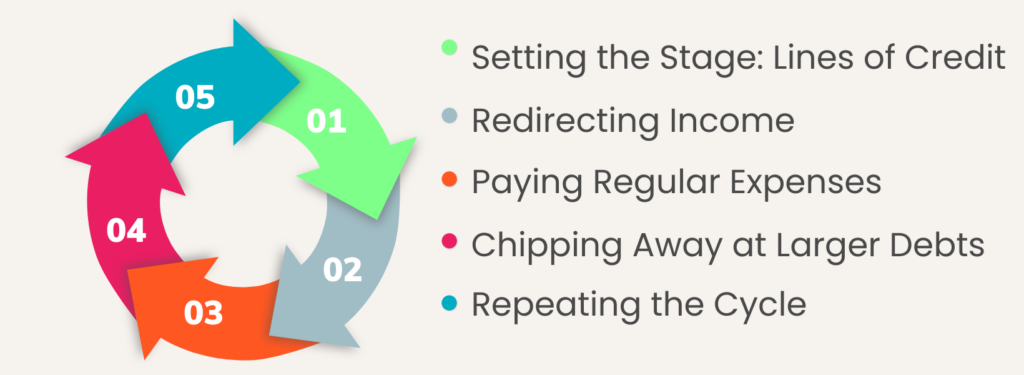
In the realm of finance, ‘velocity banking’ stands as a topic of increasing discussion among homeowners. Its methodology and implications, while layered, offer a distinctive approach to mortgage management. But what truly defines this strategy, and how does it factor into a broader financial picture? Delve into our exploration of velocity banking, equipping yourself with the insights to assess its relevance for your unique circumstances.
Understanding Velocity Banking
Velocity banking, commonly referred to as the “HELOC strategy,” revolves around leveraging a Home Equity Line of Credit (HELOC) to expedite mortgage payoff and reduce overall interest expenses. It’s like using a small stream to quickly fill a pond, ensuring the pond remains full, but at a lower cost. By leveraging certain financial tools and understanding key concepts, you can potentially save a significant amount of money on interest over the life of a loan, especially on something as substantial as a mortgage.
Key Definitions:
- Interest: This is the extra cash you owe the bank for the privilege of borrowing their money. Think of it as a ‘thank you’ gift that keeps on giving, every month.
- Home Equity: It’s like a pie chart of your house. If you’ve paid off half your mortgage, then half of that pie (or 50%) is yours, truly and fully.
- HELOC: Imagine a special kind of loan, where the bank looks at how much of your house you own (your equity) and says, “Alright, we’ll lend you money based on that!” But, there’s a catch; you pay interest on this too.
Velocity Banking in Various Scenarios
Paying Off Student Loans: With skyrocketing student loan debts, velocity banking can be a clever strategy to minimize interest and hasten repayment.
Reducing Credit Card Debts: The spiraling interest on credit card debts can be brought under control with this strategy. By allocating income towards the line of credit and managing expenses from there, you can significantly cut down on interest.
Vehicle Financing: For those grappling with auto loans, velocity banking offers a pathway to manage these debts efficiently. By leveraging a line of credit, individuals can make sizeable payments toward their auto loans. Consequently, as with other debts, the interest accrued diminishes, leading to quicker repayment of the principal amount.

How Does Velocity Banking Work?
1. Setting the Stage: Lines of Credit
First and foremost, an individual opens a Home Equity Line of Credit (HELOC) or a personal line of credit. This line of credit serves as the primary tool for implementing the Velocity Banking strategy.
2. Redirecting Income
Instead of depositing your paycheck into a traditional checking account, it’s deposited into the HELOC or line of credit. This act immediately reduces the principal balance of the HELOC, thus lowering the amount of interest you’re charged.
3. Paying Regular Expenses
From the HELOC or line of credit, you’ll pay all of your monthly bills and living expenses. The idea is to keep the balance on the line of credit as low as possible for as long as possible each month, reducing the average daily balance and, consequently, the interest charged.
4. Chipping Away at Larger Debts
Periodically, you’ll take a chunk from the HELOC or line of credit and apply it toward your primary mortgage or other significant debts. This act reduces the principal balance of these larger loans, accelerating their payoff.
5. Repeating the Cycle
As the balance on the line of credit is paid down from incoming paychecks, the process continues cyclically. Over time, the principal on larger loans diminishes rapidly, saving significant sums in potential interest.

Benefits of Velocity Banking
- Faster Debt Payoff:
- By continually reducing the principal amounts on larger loans, you can shave off years from your mortgage or other significant debts.
- Significant Interest Savings
- The core philosophy of Velocity Banking revolves around minimizing interest. With reduced principal and efficient management of lines of credit, you can save a considerable amount in potential interest payments.
- Enhanced Financial Flexibility
- With a line of credit acting as a financial buffer, it becomes easier to manage cash flow and navigate unexpected financial challenges.
- Empowerment and Control
- Velocity Banking puts you in the driver’s seat of your financial journey, granting a sense of control over debts and a clearer path to financial freedom.
What Are The Risks of Velocity Banking?
Like any financial strategy, velocity banking does come with its risks:
- Financial Discipline: Velocity banking demands rigorous financial discipline. If you’re not careful with your expenses or if you divert from the strategy, you can end up accruing more debt instead of reducing it.
- Variable Interest Rates: Many HELOCs have variable interest rates, meaning the rate can increase based on market conditions. If the rate rises significantly, it could hamper your ability to pay down the principal as quickly as anticipated.
- Dependence on Consistent Income: This strategy works best when there’s a consistent inflow of income. If there’s a disruption in your earnings, it might affect the effectiveness of the velocity banking method.
- Over-reliance on Property Value: If there’s a dip in property values, and your home’s worth decreases, it might impact the available equity in your HELOC.
- Potential for Overspending: With easy access to the line of credit, there may be a temptation to overspend, leading to higher balances and defeating the strategy’s purpose.
Best Practices for Implementing Velocity Banking
1. Understand the Terms of Your HELOC
It’s imperative to be well-acquainted with the terms, especially the interest rate and any potential fees. A HELOC with unfavorable terms might render the Velocity Banking strategy counterproductive.
2. Stay Disciplined with Spending
The success of this strategy is contingent upon disciplined spending habits. Using the HELOC for unplanned or extravagant expenses can quickly derail the plan.
3. Regularly Review and Adjust
Given that financial situations and market conditions can change, regularly reviewing and, if necessary, tweaking your Velocity Banking strategy is crucial for continued success.
Conclusion
Velocity banking is an innovative approach to mortgage payoff that, when implemented with diligence and discipline, can save homeowners substantial amounts in interest payments. While the strategy requires a thorough understanding and a robust financial discipline, for many, the benefits far outweigh the risks. Before making a decision, consider seeking advice from financial professionals well-versed in mortgage acceleration techniques.
FAQs
- Is a HELOC the only way to practice velocity banking?
While HELOCs are commonly used, any line of credit can potentially be used, provided the strategy is adapted appropriately. - What if the housing market crashes?
It’s essential to be aware of market dynamics. In any downturn, property values might decrease, which could impact your home’s equity and HELOC. - How do interest rates affect this strategy?
Variable interest rates, especially those of HELOCs, can influence the effectiveness of velocity banking. Keeping a close watch on rate trends is vital. - What is the difference between velocity banking and infinite banking?
Velocity banking focuses on using a personal line of credit (e.g., HELOC) to accelerate debt repayment. In contrast, infinite banking relies on a whole life insurance policy, utilizing its cash value for wealth accumulation and financing expenses. - Is velocity banking suitable for everyone?
Not necessarily. It depends on an individual’s financial situation, goals, and risk tolerance. Always consult with a financial advisor before implementing.






This is a great little website!